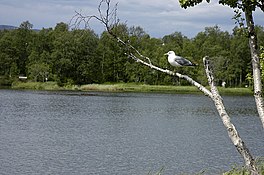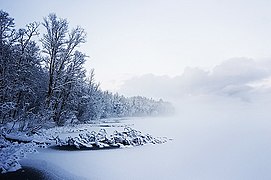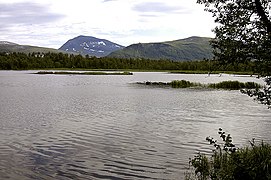| Prestvannet (Norwegian) Báhpajávri (Northern Sami) | |
|---|---|
 | |
 Interactive map of the lake | |
| Location | Troms |
| Coordinates | 69°39′34″N 18°56′09″E / 69.6594°N 18.9359°E |
| Type | Historic reservoir |
| Basin countries | Norway |
| Built | 1867 |
| Max. length | 400 metres (1,300 ft) |
| Max. width | 300 metres (980 ft) |
| Surface area | 8.1 hectares (20 acres) |
| Average depth | 4 metres (13 ft) |
| Shore length1 | 1.3 kilometres (0.81 mi) |
| Surface elevation | 96 metres (315 ft) |
| Settlements | Tromsø |
| References | NVE |
| 1 Shore length is not a well-defined measure. | |
Prestvannet (Norwegian) or Báhpajávri (Northern Sami)[1] is a small lake in Tromsø Municipality in Troms county, Norway. The lake sits at the highest point on the central part of the island of Tromsøya inside the city of Tromsø. Prestvannet was built up as a reservoir in 1867, and continued in that role until 1921. Since then it has been used as park land and a nature reserve.
The pond area has been preserved as a nesting place for various birds. The pond and its surrounding wooded area form an important natural area for the Tromsø area. Encircling the pond is a track commonly used for recreational activities and sports, as well as a nature trail with plaques giving information about the local wildlife. In the winter, the frozen pond is a popular place for ice skating.
Geography
[edit]Prestvannet is fully surrounded by Tromsø urban environment. The lake is located in the southern region of Tromsøya, with 96 meter elevation. At its deepest point the lake is four meters deep.
Ecology
[edit]Prestvannet is eutrophic and sampling in 2005 found high saturation of phosphorus.
Media gallery
[edit]-
Prestvannet during winter.
-
View towards southwest. The tall mountain in the background is Middagstind on Kvaløya.
-
Nature path near Prestvannet
-
Another view of the lake
References
[edit]- ^ "Informasjon om stadnamn". Norgeskart (in Norwegian). Kartverket. Retrieved 2024-07-10.




Well, that’s interesting to know that Psilotum nudum are known as whisk ferns. Psilotum nudum is the commoner species of the two. While the P. flaccidum is a rare species and is found in the tropical islands. Both the species are usually epiphytic in habit and grow upon tree ferns. These species may also be terrestrial and grow in humus or in the crevices of the rocks.
View the detailed Guide of Psilotum nudum: Detailed Study Of Psilotum Nudum (Whisk Fern), Classification, Anatomy, Reproduction